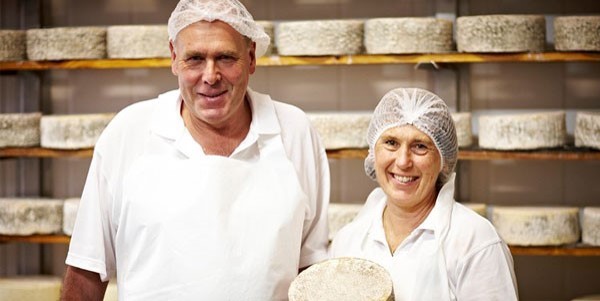Exactly How Floridia Cheese Melbourne Sets the Requirement for Neighborhood Cheese Makers
Exactly How Floridia Cheese Melbourne Sets the Requirement for Neighborhood Cheese Makers
Blog Article
Opening the Secrets of Artisanal Cheese Making: A Step-by-Step DIY Overview
In the realm of culinary workmanship, artisanal cheese making stands as a testament to the fragile equilibrium in between practice and technology. As we embark on this journey to demystify the art of developing beautiful cheeses, we are encountered with a tapestry of skills and tricks waiting to be unwinded.
Picking the Right Milk
When beginning on the journey of artisanal cheese making, the choice of milk plays a vital role in determining the quality and characteristics of the final product. The sort of milk chosen influences the flavor, structure, and overall profile of celebrity. Raw milk, right from the animal, is favored by numerous artisanal cheesemakers due to its special blend of enzymes, bacteria, and flavor substances. Making use of raw milk comes with laws and threats, making pasteurized milk a more secure alternative for beginners.
When choosing milk for cheese production, it is essential to think about the fat material. Greater fat content in milk can cause a creamier and richer cheese, while lower fat material may lead to a drier and firmer appearance. Additionally, the source of the milk, whether from cows, goats, lamb, or buffalo, contributes distinct flavors and attributes to the cheese (Floridia Cheese). Each kind of milk brings its very own nuances, permitting a variety of cheese varieties to be crafted based upon the picked milk. Eventually, the option of milk is a fundamental decision that establishes the foundation for a successful artisanal cheese-making undertaking.
Culturing and Coagulating
To initiate the cheese-making procedure, the critical actions of culturing and coagulating should be very carefully implemented to change milk into curds and whey. Culturing involves presenting helpful bacteria to the milk, which then begins the fermentation procedure. These microorganisms convert lactose (milk sugar) into lactic acid, creating the acidic setting essential for coagulation. The sort of culture utilized can dramatically impact the flavor, appearance, and ripening of the final cheese product.

The timing and temperature level control during culturing and coagulation are critical variables that affect the final end result of the cheese. Correct execution of these steps is important to make sure the desired structure, taste, and uniformity of the artisanal cheese being generated.
Draining Pipes and Pressing Curds
After the milk proteins have actually coagulated and the curds have been cut to launch whey, the following essential action in artisanal cheese making involves draining and pushing the curds to attain the desired structure and uniformity of the last cheese item. The time for draining can vary depending on the type of cheese being made and the wanted moisture material.
As soon as the curds have actually sufficiently drained pipes, the following step is pressing. Pressing assists eliminate any staying whey and compacts the curds to develop a strong cheese wheel. click reference Pressing can be done making use of specialized cheese presses that apply regular and mild stress over an amount of time. The period and stress applied during pressing will influence the last appearance of celebrity, from soft and creamy to hard and firm. Appropriate pushing and draining pipes are crucial steps that considerably affect the high quality and characteristics of the artisanal cheese being produced.
Aging and Flavor Methods
Carrying out careful aging and flavor methods is critical in enhancing the deepness and intricacy of artisanal cheeses, raising their taste accounts to exquisite degrees of refinement and sophistication. Aging plays a vital role in establishing the unique tastes and appearances that distinguish artisanal cheeses. Throughout the aging process, cheeses are saved in carefully regulated atmospheres where elements such as airflow, moisture, and temperature are adjusted to motivate the development of helpful molds and microorganisms. This controlled environment permits the cheese to mature slowly, developing complicated fragrances and rich tastes.
Flavoring strategies also contribute dramatically to the final taste of artisanal cheeses. Cheesemakers might pick to present additional flavors by incorporating ingredients such as natural herbs, spices, and even fruits into the cheese during the manufacturing procedure. Additionally, some cheeses are washed or scrubed with different fluids, such as salt water or alcohol, to boost their flavors and structures.
Covering and Saving Cheeses

Final Thought
In look at this now final thought, mastering the art of artisanal cheese making includes meticulously picking the ideal milk, complying with exact culturing and coagulating processes, draining and pushing curds successfully, and utilizing different aging and flavoring techniques. Keep in mind to wrap and save your cheeses appropriately to make certain ideal taste and texture growth.
Each type of milk brings its own subtleties, view publisher site allowing for a vast variety of cheese selections to be crafted based on the chosen milk.After the milk proteins have coagulated and the curds have actually been cut to release whey, the following essential step in artisanal cheese making involves draining and pushing the curds to attain the preferred structure and uniformity of the final cheese product. The majority of cheeses should be wrapped in wax paper or cheese paper to allow them to take a breath while protecting them from drying out. For cheeses that require to continue aging, such as bloomy peels or cleaned skins, ensure they are saved in an amazing setting like a cheese cavern or a refrigerator set to the appropriate temperature level. By paying attention to the covering and storage of artisanal cheeses, cheese makers and lovers can protect the integrity of these specials and fully appreciate their intricate tastes.
Report this page